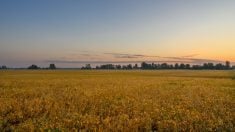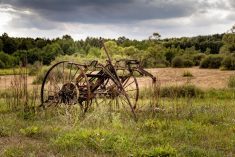Dramatic shifts in soil moisture are again bringing anthrax spores to the surface on the Prairies, this time in a southeastern Saskatchewan sheep pasture.
Lab results on Wednesday confirmed anthrax as the cause of death of one animal in a flock of sheep in the R.M. of South Qu’Appelle, about 50 km east of Regina, the provincial ag department said.
The bacterial disease remains the suspected cause of death of four other sheep on the same premises, the province said in a release Thursday.
The pathogen, Bacillus anthracis, can survive in spore form for decades in soil and those spores can build up on pastures due to changes in soil moisture, whether from flooding or drying, the province said.
Read Also

U.S. livestock: Cattle fall sharply as Trump says he’s working to lower beef costs
Chicago cattle futures fell sharply on Friday after U.S. President Donald Trump said his administration was working to lower the…
Animals are at increased risk of exposure to anthrax in drier years when areas normally known to be sloughs or potholes dry up and become accessible, or when ground is excavated or sees excessive runoff.
Infections occur when forage contaminated with spores is eaten by livestock; ruminants such as bison, cattle, sheep and goats are known to be “highly susceptible.” Affected animals are usually found dead without any signs of illness.
Horses can also be infected, the province said, while swine, birds and carnivore species are more resistant to infection. That said, farm dogs and cats should be kept away from carcasses, the province added.
Producers in regions known to have had anthrax outbreaks are “strongly encouraged” to vaccinate their animals each year, the province said, particularly if a neighbour’s animals are confirmed to have been infected.
Saskatchewan’s most recent previous confirmed case of anthrax infection in livestock was in bison in the nearby R.M. of Chester in 2019.
People are at “minimal” risk of exposure from infected animals but can be infected through direct contact with sick animals or carcasses, the province said. People who believe they have been exposed to an infected animal should contact a doctor or the local health authority.
Carcasses of animals suspected to have been infected shouldn’t be disturbed, but should be protected from scavenger animals such as coyotes or ravens, to avoid spreading spores in the environment.
Anthrax is a reportable disease, meaning veterinarians and labs must report all positive test results to the province’s chief veterinary officer within 24 hours. A producer who suspects anthrax in livestock should contact a local veterinarian immediately.
While anthrax is also still federally reportable, the Canadian Food Inspection Agency stopped actively investigating cases of anthrax in livestock in 2013.
Saskatchewan in 2014 set up a provincial anthrax response strategy, intended to help affected producers in protecting animal and public health. — Glacier FarmMedia Network
















